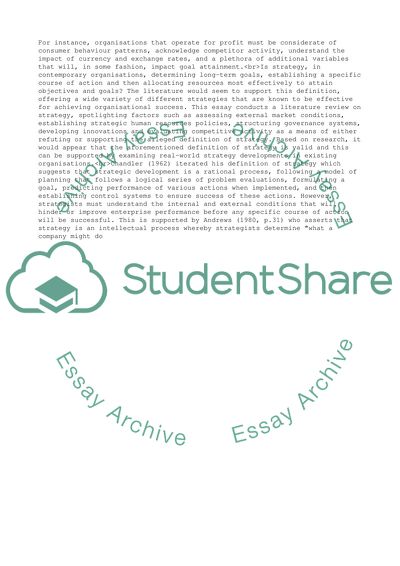Cite this document
(A classical definition of strategy as a planned process is as follows: Essay, n.d.)
A classical definition of strategy as a planned process is as follows: Essay. https://studentshare.org/management/1815336-a-classical-definition-of-strategy-as-a-planned-process-is-as-follows-the-determination-of-the-basic-long-term-goals-and-objectives-of-an-enterprise-and-the-adoption-of-courses-of-action-and-the-allocation-of-resources-necessary-for-those-go
A classical definition of strategy as a planned process is as follows: Essay. https://studentshare.org/management/1815336-a-classical-definition-of-strategy-as-a-planned-process-is-as-follows-the-determination-of-the-basic-long-term-goals-and-objectives-of-an-enterprise-and-the-adoption-of-courses-of-action-and-the-allocation-of-resources-necessary-for-those-go
(A Classical Definition of Strategy As a Planned Process Is As Follows: Essay)
A Classical Definition of Strategy As a Planned Process Is As Follows: Essay. https://studentshare.org/management/1815336-a-classical-definition-of-strategy-as-a-planned-process-is-as-follows-the-determination-of-the-basic-long-term-goals-and-objectives-of-an-enterprise-and-the-adoption-of-courses-of-action-and-the-allocation-of-resources-necessary-for-those-go.
A Classical Definition of Strategy As a Planned Process Is As Follows: Essay. https://studentshare.org/management/1815336-a-classical-definition-of-strategy-as-a-planned-process-is-as-follows-the-determination-of-the-basic-long-term-goals-and-objectives-of-an-enterprise-and-the-adoption-of-courses-of-action-and-the-allocation-of-resources-necessary-for-those-go.
“A Classical Definition of Strategy As a Planned Process Is As Follows: Essay”. https://studentshare.org/management/1815336-a-classical-definition-of-strategy-as-a-planned-process-is-as-follows-the-determination-of-the-basic-long-term-goals-and-objectives-of-an-enterprise-and-the-adoption-of-courses-of-action-and-the-allocation-of-resources-necessary-for-those-go.


